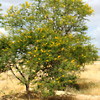Acacia horrida (syn. A. karoo) is a low spreading shrub or tree native to the wet and dry scrublands of tropical to subtropical East Africa.
This short tree or shrub 0.5-3.6 ( up to10) m tall, obconical, branching from the base, spreading, sometimes wider than high, flat-topped. The leaves are bipinnate with more than 10 leaflets. The leaflets are oblong 5mm long. The stipules are straight long (9 cm) spines, two at the base of each leaf.
As in the other species of this genus the small yellow flowers are arranged in dense globular clusters.
Acacia horrida is used as forage for livestock, for its wood and for fuel. Because of its huge thorns, it makes an excellent protective hedge. Its wood is extremely hard, and is often used in furniture making and as railings in house construction; the trunk is not straight enough to make it valuable as a timber tree. It used to be the most important tree for the tanning industry in South Africa, but extract from its bark leaves the leather with a rather bad smell.
It is extremely drought-tolerant, and may shed its leaves during the dry season.
Propagation is by seed.
Written by Amram Eshel






